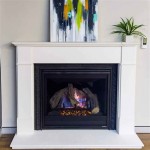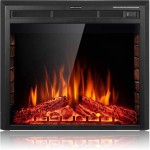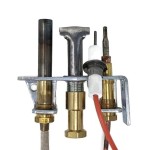The Enduring Appeal of Indoor Stone Fireplaces
Indoor stone fireplaces represent a timeless architectural feature, blending rustic charm with sophisticated design. They serve as a focal point in any room, providing warmth, visual interest, and a connection to natural materials. The selection, installation, and maintenance of a stone fireplace involve careful consideration of various factors, from the type of stone used to compliance with safety regulations.
Throughout history, fireplaces have been central to domestic life. Initially a necessity for heating and cooking, they evolved into symbols of comfort and gathering. The incorporation of stone as a building material further enhanced their durability and aesthetic appeal. Today, indoor stone fireplaces continue to be a popular choice for homeowners seeking to add character and value to their properties.
Choosing the Right Stone for Your Fireplace
Selecting the appropriate stone is crucial to achieving the desired aesthetic and ensuring the fireplace's longevity. Different types of stone offer distinct characteristics in terms of color, texture, and durability. Understanding these differences is essential for making an informed decision.
Granite, a common igneous rock, is known for its exceptional hardness and resistance to heat. Its speckled appearance, ranging from light gray to deep black, provides visual depth. Granite is a suitable choice for modern and contemporary designs, offering a sleek and robust surface.
Marble, a metamorphic rock formed from limestone, boasts a luxurious and elegant aesthetic. Its veined patterns and polished surface create a sophisticated ambiance. Marble is available in a wide array of colors, including white, gray, and various shades of brown. However, it is more porous than granite and requires sealing to protect against staining.
Limestone, a sedimentary rock composed primarily of calcium carbonate, features a more natural and earthy appearance. Its porous texture allows for excellent heat retention, making it an efficient choice for radiating warmth. Limestone is typically available in lighter colors, such as beige and cream, and can be easily carved and shaped.
Slate, a fine-grained metamorphic rock, offers a unique and contemporary look. Its layered structure and dark color palette (typically gray, black, or green) provide a dramatic contrast to lighter interior finishes. Slate is resistant to heat and moisture, making it a durable option for fireplace surrounds.
Fieldstone, natural stones collected from fields and riverbeds, imparts a rustic and organic feel. The irregular shapes and varying colors of fieldstone create a unique and textured surface. This option is well-suited for traditional and country-style homes, offering a sense of authenticity and connection to the outdoors.
Beyond the type of stone, consider the cut and finish. Natural cleft stone retains the rough, uneven surface of the stone as it was quarried, while sawn-cut stone offers a cleaner, more uniform appearance. Polished finishes enhance the stone's color and sheen, while honed finishes provide a matte, less reflective surface. The choice of cut and finish significantly impacts the overall style and ambiance of the fireplace.
Installation Considerations and Safety Regulations
The installation of an indoor stone fireplace involves specialized knowledge and skills. Proper construction is paramount to ensure structural integrity, efficient operation, and compliance with local building codes. Engaging experienced professionals is highly recommended to avoid potential hazards and long-term problems.
Structural Support: Stone fireplaces are substantial structures, requiring adequate foundation and support. The weight of the stone must be properly distributed to prevent settling or cracking. Existing floors may need reinforcement to accommodate the added load.
Firebox and Chimney: The firebox, where the fire burns, must be constructed of fire-resistant materials, such as firebrick. The chimney, responsible for venting smoke and combustion gases, must be properly sized and constructed to ensure adequate draft. Improperly installed chimneys can lead to dangerous backdrafting of carbon monoxide.
Clearance Requirements: Building codes specify minimum clearances between the fireplace and combustible materials, such as wood framing and drywall. These clearances are designed to prevent overheating and potential fire hazards. Non-combustible materials, such as cement board, can be used to provide a protective barrier.
Ventilation: Adequate ventilation is essential to ensure proper combustion and prevent the buildup of harmful gases. Some fireplaces require dedicated air inlets to provide a sufficient supply of oxygen. Carbon monoxide detectors should be installed in the vicinity of the fireplace to provide early warning of dangerous gas levels.
Gas Lines (for Gas Fireplaces): If the stone fireplace is a gas-burning model, the installation of gas lines must be performed by a qualified gas fitter. Proper connections and leak testing are crucial to prevent gas leaks and explosions.
Before commencing any installation, obtain the necessary permits from local building authorities. Inspections are typically required throughout the construction process to ensure compliance with applicable codes and standards. Failing to obtain permits or adhere to regulations can result in fines, delays, and safety hazards.
Maintaining Your Stone Fireplace
Regular maintenance is essential to preserve the beauty and functionality of your indoor stone fireplace. Proper cleaning and upkeep will prevent damage, ensure efficient operation, and prolong the lifespan of the structure.
Cleaning Ash and Debris: After each use, remove ashes and debris from the firebox. Use a fireplace shovel and broom to collect the waste, and dispose of it in a metal container with a tight-fitting lid. Cooled ashes can be used in gardens as a fertilizer supplement.
Cleaning the Stone Surface: Clean the stone surface regularly to remove soot, dust, and stains. Use a soft brush or cloth and a mild detergent solution. Avoid abrasive cleaners or scouring pads, which can scratch or damage the stone. For stubborn stains, consider using a specialized stone cleaner.
Chimney Sweeping: Schedule professional chimney sweeping at least once a year, or more frequently if the fireplace is used regularly. Chimney sweeps remove creosote, a highly flammable substance that accumulates in the chimney flue. Creosote buildup can lead to dangerous chimney fires.
Inspecting for Damage: Periodically inspect the fireplace for cracks, loose stones, or mortar deterioration. Address any issues promptly to prevent further damage and potential safety hazards. Small cracks can be repaired with mortar patching compounds, while larger repairs may require professional assistance.
Damper Maintenance: Ensure that the damper, the metal plate that controls airflow in the chimney, is functioning properly. Check for rust, corrosion, or obstructions. A malfunctioning damper can reduce fireplace efficiency and increase energy costs.
Sealing (for Porous Stones): If the fireplace is constructed of porous stone, such as marble or limestone, consider applying a sealant to protect against staining and moisture damage. Apply the sealant according to the manufacturer's instructions, and reapply as needed.
By following these maintenance guidelines, homeowners can ensure that their indoor stone fireplace remains a beautiful and functional centerpiece for years to come. Diligent care and attention will protect the investment and preserve the timeless appeal of this architectural feature.

50 Sensational Stone Fireplaces To Warm Your Senses

4 Natural Stacked Stone Fireplaces For Your Dream Design

Natural Stacked Stone Veneer Fireplace Ideas

65 Best Stone Fireplace Design Ideas To Ignite Your Decor Designs Home Farmhouse

9 Indoor Fireplaces That Will Bring Warmth And Charm To Your Home Swenson Granite 100 Natural Stones

Stone Fireplaces

Indoor Fireplace Exquisite Decor Ideas Bethlehem Masonry Supply

Stone Fireplace Modern Outdoor Melbourne

50 Sensational Stone Fireplaces To Warm Your Senses

65 Best Stone Fireplace Design Ideas To Ignite Your Decor Modern Indoor








